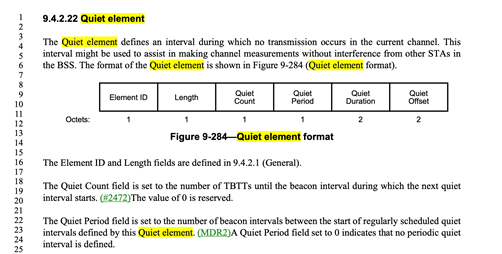Hi Yanbo,
Thanks for your answers.
I fully agree with your argumentation.
We have to enhance the current standardized 802.11 features. But all new modifications shall only be applied to the new 802.11 devices (11be). So you can not quiet legacy devices in that case.
Regards
Patrice
From: Yangbo (Boyce, 2012 NT Lab) <yangbo59@xxxxxxxxxx>
Sent: vendredi 11 décembre 2020 11:16
To: NEZOU Patrice <Patrice.Nezou@xxxxxxxxxxxx>; STDS-802-11-TGBE@xxxxxxxxxxxxxxxxx
Subject: 答复: [STDS-802-11-TGBE] Question on Quiet element / 1046r10
Hi, Patrice,
Yes. The md spec does not mention low latency traffic and that’s why we are trying to develop that in 11be.
I think it’s natural to extend or modify the usage of existing elements in new version of specs.
For example, TWT was originally designed for power saving for S1G. TWT setup/Teardown frames are described in 9.6.24 Unprotected S1G Action frame details.
We extend the usage of TWT in 11ax.
Regards
Boyce
发件人:
NEZOU Patrice [mailto:Patrice.Nezou@xxxxxxxxxxxx]
发送时间:
2020年12月11日
17:15
收件人:
Yangbo (Boyce, 2012 NT Lab) <yangbo59@xxxxxxxxxx>;
STDS-802-11-TGBE@xxxxxxxxxxxxxxxxx
主题:
RE: [STDS-802-11-TGBE] Question on Quiet element / 1046r10
Hi Boyce,
Thanks for your explanation on the quiet element.
I think that there are some misunderstandings related to quiet element. As Jarkko said, the quiet element is used
to measure channel especially in DFS channels to detect radars and not for other purposes.
9.4.2.22 Quiet element
[…]
The Quiet element
is
optionally present in Beacon frames, as described in 9.3.3.2 (Beacon frame format),
and Probe Response frames, as described in 9.3.3.10 (Probe Response frame format).
The use of Quiet
elements is described in 11.8.3 (Quieting channels for testing).
You are right when you said that Stéphane made a mistake between quiet element and quiet channel element. But it is the only usage of the quiet element today approved in the specifications.
And the Quiet channel element shall be used only when the BSS bandwidth is either 160MHz or 80+80MHz.
Regards.
Patrice
From: Yangbo (Boyce, 2012 NT Lab) <yangbo59@xxxxxxxxxx>
Sent: vendredi 11 décembre 2020 03:56
To: STDS-802-11-TGBE@xxxxxxxxxxxxxxxxx
Subject: [STDS-802-11-TGBE] 答复: [STDS-802-11-TGBE] Question on Quiet element / 1046r10
Hi Stephane,
I think you mix
quiet element and quiet channel element.
Quiet channel element is introduced in 11ac as complement to quiet element in case of 160MHz or 80+80 bandwidth.
If the bandwidth is neither 160Mhz nor 80+80 Mhz, AP should use quiet element only.
Regards
Boyce
发件人:
BARON Stephane [mailto:Stephane.BARON@xxxxxxxxxxxx]
发送时间:
2020年12月11日
10:43
收件人:
STDS-802-11-TGBE@xxxxxxxxxxxxxxxxx
主题:
Re: [STDS-802-11-TGBE] Question on Quiet element / 1046r10
Hi Chunyu,
I agree with Jarkko that additional discussion is needed for the usage of the Quiet element.
If I understand well, the interest of the usage of the quiet element for low latency, is to quiet all stations, especially legacy stations.
However, some limitations exit on the usage of the quiet element that make it interesting only for few cases for low latency.
For instance, only 160MHz BSS bandwidth supports this feature.
11.8.3 Quieting channels for testing
[…]
A non-VHT AP shall not transmit a Quiet Channel element. An AP shall not transmit a Quiet Channel
element
with the AP Quiet Mode field value equal to 0 in frames that do not include at least one Quiet
element. An AP
shall not transmit more than one Quiet Channel element with the AP Quiet Mode field equal to
0. An AP shall
not transmit a Quiet Channel element if the BSS bandwidth
is neither 160 MHz nor 80+80 MHz.
This implies that even if we modify the rules for 11be, legacy stations may not support it for other bandwidths than 160MHz.
So additional mechanism will be required to solve same issue on other bandwidths.
As I mentioned during your presentation, I agree on the direction, but I think more discussions are needed.
I have a document on the server (1843r1) that can provide a mechanism fully compatible
with your proposal dealing with same issue.
Best regards.
Stéphane.
From: Jarkko Kneckt <00000d5619618f4f-dmarc-request@xxxxxxxxxxxxxxxxx>
Sent: vendredi 11 décembre 2020 02:04
To: STDS-802-11-TGBE@xxxxxxxxxxxxxxxxx
Subject: [STDS-802-11-TGBE] Question on Quiet element / 1046r10
Hi Chunyu and all,
There was a long queue of questions to 1046r10 and I was not able to ask my question.
I am wondering how to use Quiet element to protect real time traffic.
Quiet element was designed to measure channel especially in DFS channels to detect radars.
The Quiet Period is given in units of Beacon periods. Low latency traffic likely transmits more often than once per Beacon period.
I am wondering how you are planning to use the Quiet elements to protect the low latency traffic? Are you planning to include multiple Quiet elements to Beacon or just protect all time
for restricted TWT?
Cheers,
Jarkko

To unsubscribe from the STDS-802-11-TGBE list, click the following link:
https://listserv.ieee.org/cgi-bin/wa?SUBED1=STDS-802-11-TGBE&A=1
To unsubscribe from the STDS-802-11-TGBE list, click the following link:
https://listserv.ieee.org/cgi-bin/wa?SUBED1=STDS-802-11-TGBE&A=1
To unsubscribe from the STDS-802-11-TGBE list, click the following link:
https://listserv.ieee.org/cgi-bin/wa?SUBED1=STDS-802-11-TGBE&A=1
To unsubscribe from the STDS-802-11-TGBE list, click the following link: https://listserv.ieee.org/cgi-bin/wa?SUBED1=STDS-802-11-TGBE&A=1